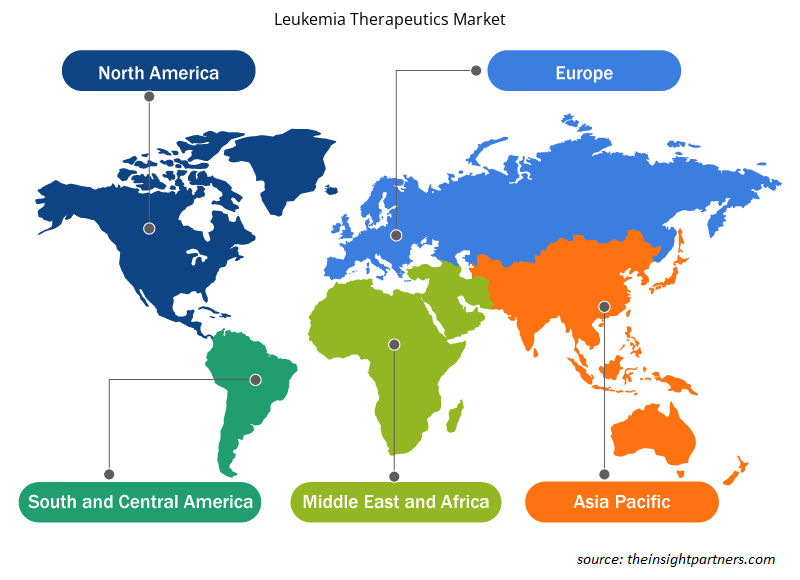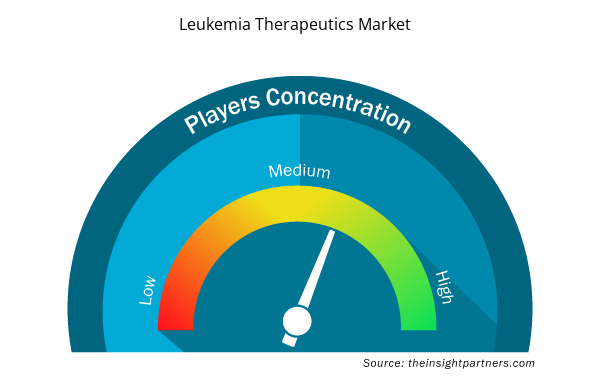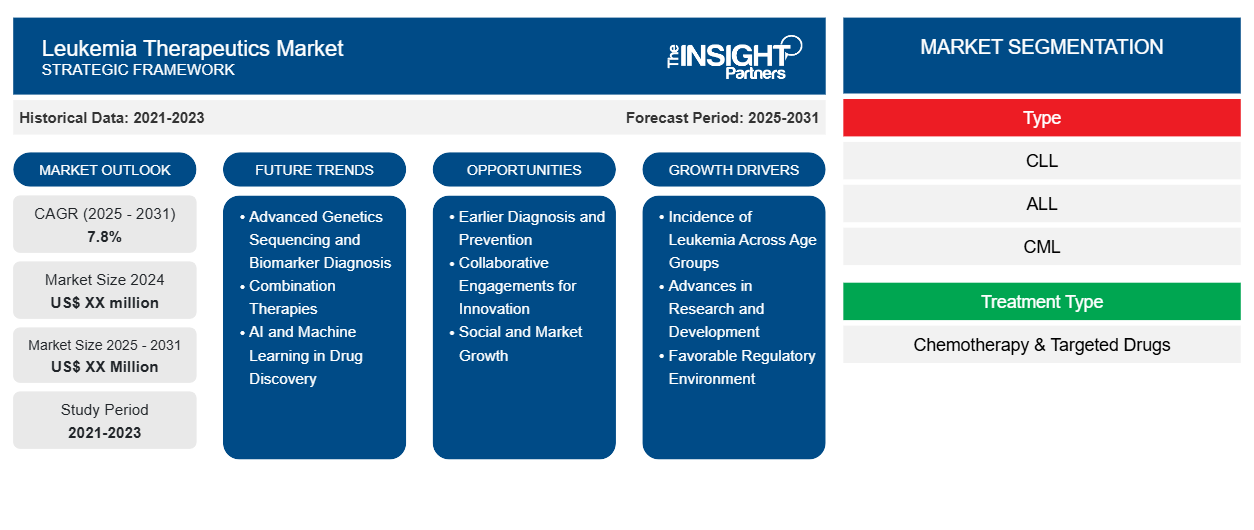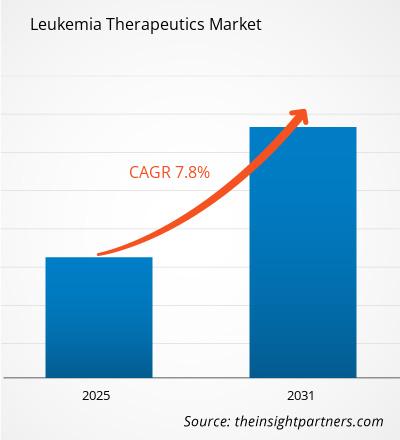Se espera que el mercado de terapias contra la leucemia registre una CAGR del 7,8 % entre 2023 y 2031, con un tamaño de mercado que se expandirá de US$ XX millones en 2023 a US$ XX millones en 2031.
El informe de investigación de mercado de Leukemia Therapeutics está segmentado por tipo en los siguientes subsegmentos: LLC, ALL, CML y AML. El informe proporciona además un análisis basado en el tipo de tratamiento, es decir, quimioterapia y medicamentos dirigidos. El mercado también está segmentado por modo de administración, que incluye oral e inyectable, y tipo de molécula, es decir, moléculas pequeñas y productos biológicos. La evaluación del mercado se presenta en dólares estadounidenses para el análisis segmentario anterior.
Propósito del Informe
El informe Leukemia Therapeutics Market de The Insight Partners tiene como objetivo describir el panorama actual y el crecimiento futuro, los principales factores impulsores, los desafíos y las oportunidades. Esto proporcionará información a diversas partes interesadas del negocio, como:
- Proveedores/fabricantes de tecnología: Para comprender la dinámica cambiante del mercado y conocer las oportunidades potenciales de crecimiento, lo que les permitirá tomar decisiones estratégicas informadas.
- Inversionistas: Realizar un análisis exhaustivo de tendencias sobre la tasa de crecimiento del mercado, las proyecciones financieras del mercado y las oportunidades que existen en toda la cadena de valor.
- Órganos reguladores: Regular las políticas y vigilar las actividades del mercado con el objetivo de minimizar los abusos, preservar la confianza de los inversores y defender la integridad y estabilidad del mercado.
Segmentación del mercado de terapias contra la leucemia
Tipo
- LLC
- TODO
- LMC
- Lesión cerebral leve (LMA)
Tipo de tratamiento
- Quimioterapia y fármacos específicos
Modo de administración
- Oral
- Inyectable
Tipo de molécula
- Moléculas pequeñas
- Biológicos
Tipo de molécula
- Moléculas pequeñas
- Biológicos
Personalice este informe según sus necesidades
Obtendrá personalización en cualquier informe, sin cargo, incluidas partes de este informe o análisis a nivel de país, paquete de datos de Excel, así como también grandes ofertas y descuentos para empresas emergentes y universidades.
- Obtenga las principales tendencias clave del mercado de este informe.Esta muestra GRATUITA incluirá análisis de datos, desde tendencias del mercado hasta estimaciones y pronósticos.
Factores impulsores del crecimiento del mercado de terapias contra la leucemia
- Incidencia de leucemia en distintos grupos etarios: la creciente incidencia de leucemia en distintos grupos etarios es un impulsor clave del crecimiento del mercado, creando una demanda de tratamientos más efectivos y mejores resultados para los pacientes.
- Avances en investigación y desarrollo: las innovaciones en terapias dirigidas, inmunoterapias y terapias con células CAR-T han mejorado significativamente los resultados de los pacientes, impulsando el crecimiento del mercado.
- Entorno regulatorio favorable: la colaboración entre compañías farmacéuticas, instituciones académicas y proveedores de servicios, respaldada por un entorno regulatorio favorable, acelera el desarrollo y la comercialización de nuevas terapias.
Tendencias futuras del mercado de terapias contra la leucemia
- Secuenciación genética avanzada y diagnóstico de biomarcadores: el uso de secuenciación genética avanzada y diagnósticos basados en biomarcadores mejora la sensibilidad y especificidad del diagnóstico de leucemia, respaldando estrategias terapéuticas específicas.
- Terapias combinadas: La combinación de múltiples medicamentos para lograr una acción más efectiva y reducir los efectos secundarios se está convirtiendo en una tendencia importante en el tratamiento de la leucemia, mejorando los resultados terapéuticos generales.
- IA y aprendizaje automático en el descubrimiento de fármacos: la creciente adopción de inteligencia artificial (IA) y aprendizaje automático (ML) acelerará el descubrimiento y la optimización de nuevas terapias para la leucemia.
Oportunidades de mercado en terapias contra la leucemia
- Diagnóstico y prevención precoces: un mayor reconocimiento de la necesidad de un diagnóstico precoz y de medidas preventivas conducirá a una intervención más temprana, mejorando el pronóstico y los resultados de los pacientes.
- Compromisos colaborativos para la innovación: las colaboraciones entre compañías farmacéuticas, instituciones académicas y proveedores de atención médica acelerarán el desarrollo y la comercialización de terapias innovadoras, beneficiando tanto al mercado como a los pacientes.
- Crecimiento social y de mercado: el alivio de las necesidades médicas no satisfechas y las mejoras en la calidad de vida de los pacientes impulsarán tanto el crecimiento del mercado como los beneficios sociales en el sector terapéutico de la leucemia.
Perspectivas regionales del mercado de terapias contra la leucemia
Los analistas de Insight Partners explicaron en detalle las tendencias y los factores regionales que influyen en el mercado de terapias contra la leucemia durante el período de pronóstico. Esta sección también analiza los segmentos y la geografía del mercado de terapias contra la leucemia en América del Norte, Europa, Asia Pacífico, Oriente Medio y África, y América del Sur y Central.

- Obtenga datos regionales específicos para el mercado de terapias contra la leucemia
Alcance del informe sobre el mercado de productos terapéuticos contra la leucemia
| Atributo del informe | Detalles |
|---|---|
| Tamaño del mercado en 2023 | XX millones de dólares estadounidenses |
| Tamaño del mercado en 2031 | US$ XX millones |
| CAGR global (2023 - 2031) | 7,8% |
| Datos históricos | 2021-2022 |
| Período de pronóstico | 2024-2031 |
| Segmentos cubiertos | Por tipo
|
| Regiones y países cubiertos | América del norte
|
| Líderes del mercado y perfiles de empresas clave |
|
Densidad de actores del mercado de terapias contra la leucemia: comprensión de su impacto en la dinámica empresarial
El mercado de productos terapéuticos para la leucemia está creciendo rápidamente, impulsado por la creciente demanda de los usuarios finales debido a factores como la evolución de las preferencias de los consumidores, los avances tecnológicos y una mayor conciencia de los beneficios del producto. A medida que aumenta la demanda, las empresas amplían sus ofertas, innovan para satisfacer las necesidades de los consumidores y aprovechan las tendencias emergentes, lo que impulsa aún más el crecimiento del mercado.
La densidad de actores del mercado se refiere a la distribución de las empresas o firmas que operan dentro de un mercado o industria en particular. Indica cuántos competidores (actores del mercado) están presentes en un espacio de mercado determinado en relación con su tamaño o valor total de mercado.
Las principales empresas que operan en el mercado de terapias contra la leucemia son:
- Novartis AG
- AbbVie Inc
- Compañía Bristol-Myers Squibb
- F. Hoffmann-La Roche Ltd
- Sanofi
Descargo de responsabilidad : Las empresas enumeradas anteriormente no están clasificadas en ningún orden particular.

- Obtenga una descripción general de los principales actores clave del mercado de terapias contra la leucemia
Puntos de venta clave
- Cobertura integral: el informe cubre de manera integral el análisis de productos, servicios, tipos y usuarios finales del mercado de terapias contra la leucemia, proporcionando un panorama holístico.
- Análisis de expertos: el informe se compila sobre la base de un profundo conocimiento de expertos y analistas de la industria.
- Información actualizada: El informe asegura relevancia comercial debido a su cobertura de información reciente y tendencias de datos.
- Opciones de personalización: este informe se puede personalizar para satisfacer los requisitos específicos del cliente y adaptarse adecuadamente a las estrategias comerciales.
Por lo tanto, el informe de investigación sobre el mercado de productos terapéuticos para la leucemia puede ayudar a abrir camino para descifrar y comprender el escenario de la industria y las perspectivas de crecimiento. Si bien puede haber algunas preocupaciones válidas, los beneficios generales de este informe tienden a superar las desventajas.
- Análisis histórico (2 años), año base, pronóstico (7 años) con CAGR
- Análisis PEST y FODA
- Tamaño del mercado Valor/volumen: global, regional, nacional
- Industria y panorama competitivo
- Conjunto de datos de Excel



Report Coverage
Revenue forecast, Company Analysis, Industry landscape, Growth factors, and Trends

Segment Covered
This text is related
to segments covered.

Regional Scope
North America, Europe, Asia Pacific, Middle East & Africa, South & Central America

Country Scope
This text is related
to country scope.
Preguntas frecuentes
The leading players are: Novartis AG, AbbVie Inc, Bristol-Myers Squibb Company, F. Hoffmann-La Roche Ltd, Sanofi, Pfizer Inc, Amgen Inc, Gilead Sciences, Inc., Takeda Pharmaceutical Company Limited, CELGENE CORPORATION
The report can be delivered in PDF/PPT format; we can also share excel dataset based on the request.
Some of the customization options available based on request are additional 3-5 company profiles and country-specific analysis of 3-5 countries of your choice. Customizations are to be requested/discussed before making final order confirmation, as our team would review the same and check the feasibility.
In the years to come, the Leukemia Therapeutics market is likely to witness tremendous growth due to several trends that have begun to emerge. Personalized medicine will provide more accurate diagnosis and treatment through better use of genetic sequencing and biomarker analyses. Combination therapies have come to the fore with the strategy of applying more than one drug to increase efficacy and reduce side effects. The use of artificial intelligence and machine learning accelerates drug discovery and development to identify new therapeutics. Emphasis on early detection and prevention strategies, such as blood tests and lifestyle modifications, has also been reported to enhance patient outcomes and market growth.
Leukemia Therapeutics Market is expected to grow at a CAGR of 7.8% between 2023-2031
The market for Leukemia Therapeutics is basically driven by the growing prevalence of leukemia in the elderly population. Advances in research and development have brought innovative therapies into the market, such as targeted therapies, immunotherapies, and CAR-T cell therapies, promising better outcomes. The market is also fueled by the increasing expenditure in healthcare and growing awareness about early diagnosis and treatment options. The enabling regulatory environment and partnerships among pharmaceutical firms, academia, and healthcare service providers further facilitate innovation in new therapies, thereby driving overall growth in the Leukemia Therapeutics Market.
Trends and growth analysis reports related to Life Sciences : READ MORE..
1. Novartis AG
2. AbbVie Inc
3. Bristol-Myers Squibb Company
4. F. Hoffmann-La Roche Ltd
5. Sanofi
6. Pfizer Inc
7. Amgen Inc
8. Gilead Sciences, Inc.
9. Takeda Pharmaceutical Company Limited
10. CELGENE CORPORATION
11. AstraZeneca plc
12. Incyte Corp
13. Johnson & Johnson
14. Merck & Co., Inc.
15. Clovis Oncology
16. Boehringer Ingelheim International GmbH
17. GlaxoSmithKline plc
18. Exelixis, Inc
19. MorphoSys AG
20. Ono Pharmaceutical Co.
The Insight Partners performs research in 4 major stages: Data Collection & Secondary Research, Primary Research, Data Analysis and Data Triangulation & Final Review.
- Data Collection and Secondary Research:
As a market research and consulting firm operating from a decade, we have published and advised several client across the globe. First step for any study will start with an assessment of currently available data and insights from existing reports. Further, historical and current market information is collected from Investor Presentations, Annual Reports, SEC Filings, etc., and other information related to company’s performance and market positioning are gathered from Paid Databases (Factiva, Hoovers, and Reuters) and various other publications available in public domain.
Several associations trade associates, technical forums, institutes, societies and organization are accessed to gain technical as well as market related insights through their publications such as research papers, blogs and press releases related to the studies are referred to get cues about the market. Further, white papers, journals, magazines, and other news articles published in last 3 years are scrutinized and analyzed to understand the current market trends.
- Primary Research:
The primarily interview analysis comprise of data obtained from industry participants interview and answers to survey questions gathered by in-house primary team.
For primary research, interviews are conducted with industry experts/CEOs/Marketing Managers/VPs/Subject Matter Experts from both demand and supply side to get a 360-degree view of the market. The primary team conducts several interviews based on the complexity of the markets to understand the various market trends and dynamics which makes research more credible and precise.
A typical research interview fulfils the following functions:
- Provides first-hand information on the market size, market trends, growth trends, competitive landscape, and outlook
- Validates and strengthens in-house secondary research findings
- Develops the analysis team’s expertise and market understanding
Primary research involves email interactions and telephone interviews for each market, category, segment, and sub-segment across geographies. The participants who typically take part in such a process include, but are not limited to:
- Industry participants: VPs, business development managers, market intelligence managers and national sales managers
- Outside experts: Valuation experts, research analysts and key opinion leaders specializing in the electronics and semiconductor industry.
Below is the breakup of our primary respondents by company, designation, and region:

Once we receive the confirmation from primary research sources or primary respondents, we finalize the base year market estimation and forecast the data as per the macroeconomic and microeconomic factors assessed during data collection.
- Data Analysis:
Once data is validated through both secondary as well as primary respondents, we finalize the market estimations by hypothesis formulation and factor analysis at regional and country level.
- Macro-Economic Factor Analysis:
We analyse macroeconomic indicators such the gross domestic product (GDP), increase in the demand for goods and services across industries, technological advancement, regional economic growth, governmental policies, the influence of COVID-19, PEST analysis, and other aspects. This analysis aids in setting benchmarks for various nations/regions and approximating market splits. Additionally, the general trend of the aforementioned components aid in determining the market's development possibilities.
- Country Level Data:
Various factors that are especially aligned to the country are taken into account to determine the market size for a certain area and country, including the presence of vendors, such as headquarters and offices, the country's GDP, demand patterns, and industry growth. To comprehend the market dynamics for the nation, a number of growth variables, inhibitors, application areas, and current market trends are researched. The aforementioned elements aid in determining the country's overall market's growth potential.
- Company Profile:
The “Table of Contents” is formulated by listing and analyzing more than 25 - 30 companies operating in the market ecosystem across geographies. However, we profile only 10 companies as a standard practice in our syndicate reports. These 10 companies comprise leading, emerging, and regional players. Nonetheless, our analysis is not restricted to the 10 listed companies, we also analyze other companies present in the market to develop a holistic view and understand the prevailing trends. The “Company Profiles” section in the report covers key facts, business description, products & services, financial information, SWOT analysis, and key developments. The financial information presented is extracted from the annual reports and official documents of the publicly listed companies. Upon collecting the information for the sections of respective companies, we verify them via various primary sources and then compile the data in respective company profiles. The company level information helps us in deriving the base number as well as in forecasting the market size.
- Developing Base Number:
Aggregation of sales statistics (2020-2022) and macro-economic factor, and other secondary and primary research insights are utilized to arrive at base number and related market shares for 2022. The data gaps are identified in this step and relevant market data is analyzed, collected from paid primary interviews or databases. On finalizing the base year market size, forecasts are developed on the basis of macro-economic, industry and market growth factors and company level analysis.
- Data Triangulation and Final Review:
The market findings and base year market size calculations are validated from supply as well as demand side. Demand side validations are based on macro-economic factor analysis and benchmarks for respective regions and countries. In case of supply side validations, revenues of major companies are estimated (in case not available) based on industry benchmark, approximate number of employees, product portfolio, and primary interviews revenues are gathered. Further revenue from target product/service segment is assessed to avoid overshooting of market statistics. In case of heavy deviations between supply and demand side values, all thes steps are repeated to achieve synchronization.
We follow an iterative model, wherein we share our research findings with Subject Matter Experts (SME’s) and Key Opinion Leaders (KOLs) until consensus view of the market is not formulated – this model negates any drastic deviation in the opinions of experts. Only validated and universally acceptable research findings are quoted in our reports.
We have important check points that we use to validate our research findings – which we call – data triangulation, where we validate the information, we generate from secondary sources with primary interviews and then we re-validate with our internal data bases and Subject matter experts. This comprehensive model enables us to deliver high quality, reliable data in shortest possible time.


 Obtenga una muestra gratuita de este informe
Obtenga una muestra gratuita de este informe